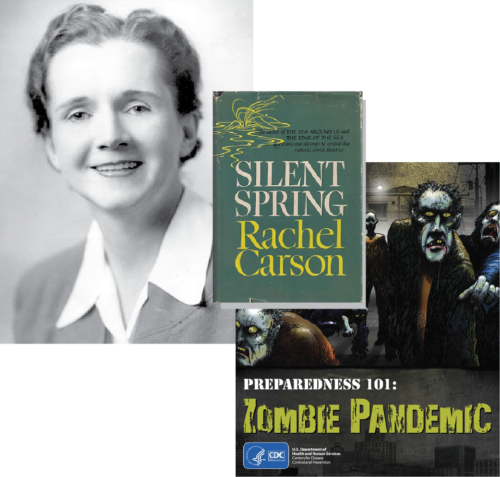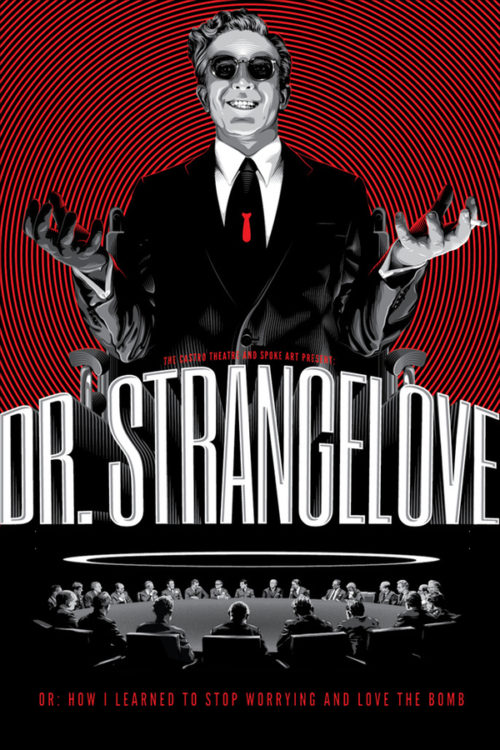Rachel Carson versus the Zombie Horde
Bill Nuttle ·Does Rachel Carson still have something to teach us about communicating science to the public? Silent Spring, Carson’s 1962 best-seller on the environmental perils of herbicides and pesticides, launched the movement that created the Environmental Protection Agency. But, the communications field has changed a lot in the last 50 years. The era of television came and went, and television’s replacement, the internet, is revolutionizing the industries of music, film, and journalism. Therefore, are there any lessons can we draw from Silent Spring that are relevant today?
For example, consider the wildly successful zombie preparedness campaign by the Centers for Disease Control (CDC). Every spring, the US Center for Disease Control launches a campaign of public service announcements to encourage the public to prepare for natural disasters. In 2011, the campaign added an online element, a blog post with tongue-in-cheek advice to prepare for a zombie apocalypse with a link to the disaster preparedness website. The zombie post went viral, and this caught the attention of the mainstream news media. The result was an estimated $3 million of free advertising for the CDC’s disaster preparedness message.

The success of the zombie campaign hinges on, well, the zombies. The vision of a world beset by a pandemic of the undead triggers something deep in the brain and grabs the attention of the still-living. That’s essential in any communication now because competition for people’s attention in today’s hyper-connected world is fierce. According to Randy Olson, scientist-turned-filmmaker-turned communications guru, the first rule of communication ought to be, “Don’t be boring!”
But, also, “Don’t be frivolous!” In spite of its success, or perhaps because of it, some at the CDC worried that poking fun with the zombie preparedness campaign would lead the public to ignore the serious message of disaster preparedness. What would Rachel Carson have done? Would she, serious-minded scientist that she was, have stuck to the course of building a reasoned argument based on the facts? Or, would her instinct as a successful writer drive her to take on the zombie horde?
Carson draws readers in by beginning Silent Spring with a mystery story, a fable of a once-vibrant town infected by a strange blight. The story unfolds with descriptions of how the blight saps the vitality out of the town and the surrounding countryside, and it draws the reader in by foreshadowing topics discussed in detail in the chapters to follow. And then, Carson keeps on telling stories. Throughout the rest of the book, Carson uses case studies to present the results of scientific studies on the impacts that herbicides and pesticides were having on the environment, ecosystems, and people.
Stories grab people’s attention because that’s how evolution has wired our brains. The effect varies based on story content, presentation style, etc., but it appears that “good” stories share a few basic characteristics. That’s the insight Randy Olson offers in his latest book, Houston We Have a Narrative. Olson boils the essence of story-telling down to how words like “and,” “but,” and “therefore” are used to link together the ideas that are a story’s building blocks.This is the basis of Olson’s and-but-therefore (ABT) template and the related metric the narrative index (NI).

We can use the narrative index to compare the strength of Carson’s story-telling in Silent Spring with other examples of effective communication. The NI is calculated from the ratio “but” vs “and” of the number of times these words appear in a text; higher numbers are better. The NI for Silent Spring is 16, which makes it comparable to books written by Charles Darwin a century earlier but less engaging than To Kill a Mockingbird, the popular novel from the same time (NI 24). It also falls short of the NI of ~20 that appears to be the lower limit for television, based on looking at a number of PBS science programs like Carl Sagan’s successful series Cosmos. Therefore, Carson might need to improve her narrative game if she were writing for today’s audiences.
Simply grabbing someone’s attention is not enough. To communicate, you also have to engage people on an emotional level. Engagement occurs through different pathways, and this is where science communication often falls short. Randy Olson describes it as the four organs of communication: head, heart, gut, and groin. Scientists prefer to engage through the head, the seat of abstract thought and logic, because this is how they communicate with each other. The problem is that they can get stuck there. The vast majority of communication occurs through pathways associated with the lower organs - sentiment, instinct, and sex. The zombie preparedness campaign succeeds by engaging people through humor, using the gut.
Carson wrote Silent Spring especially to engage the sentimental hearts and gut instincts of suburban housewives. Women in the 1960s were cast in the roll of managing the home and tending to family needs. Nonetheless, many were educated and ambitious and, as business men were discovering, they exerted tremendous influence in the marketplace. Carson targeted this audience selected case studies that illustrated the impacts of pesticides and herbicides in the home, on families with children, and on the rural landscapes that many would have remembered from their own childhood. Silent Spring was hugely successful as a selection of the Book-of-the-Month Club; housewives made the book a success.
Carson also wrote with the courage of a zombie killer; although she never had the opportunity to confront zombies directly. The image of the zombie horde entered popular culture with the classic film Night of the Living Dead, 4 years after her death. But, Carson confronted another source of widespread unease – the fear mongering by chemical firms and government agencies to justify the contamination of man’s total environment and the possible extinction of mankind from nuclear war. Silent Spring was released at the height of the Cold War and Carson draws explicit parallels between the escalating nuclear arms race and the chemical war being waged against the environment.
Science communication seeks to promote science by helping the public to better understand the results of scientific research. But, science is an inherently subversive activity. Its premise of doubt and preference for facts and logic can place scientists in conflict with more broadly shared values of good character, common sense and tradition. In Silent Spring, Carson championed the right of the public to know the facts and decide how harmful chemicals should be used. However, she also vilified trusted institutions of industry and government, accusing them of dealing in false assurances and half-truths. For this, Carson has been called the gentle subversive.
Therefore, perhaps the question that we should ask is whether science communication today can still rise to the standard of courage Rachel Carson set with Silent Spring.
